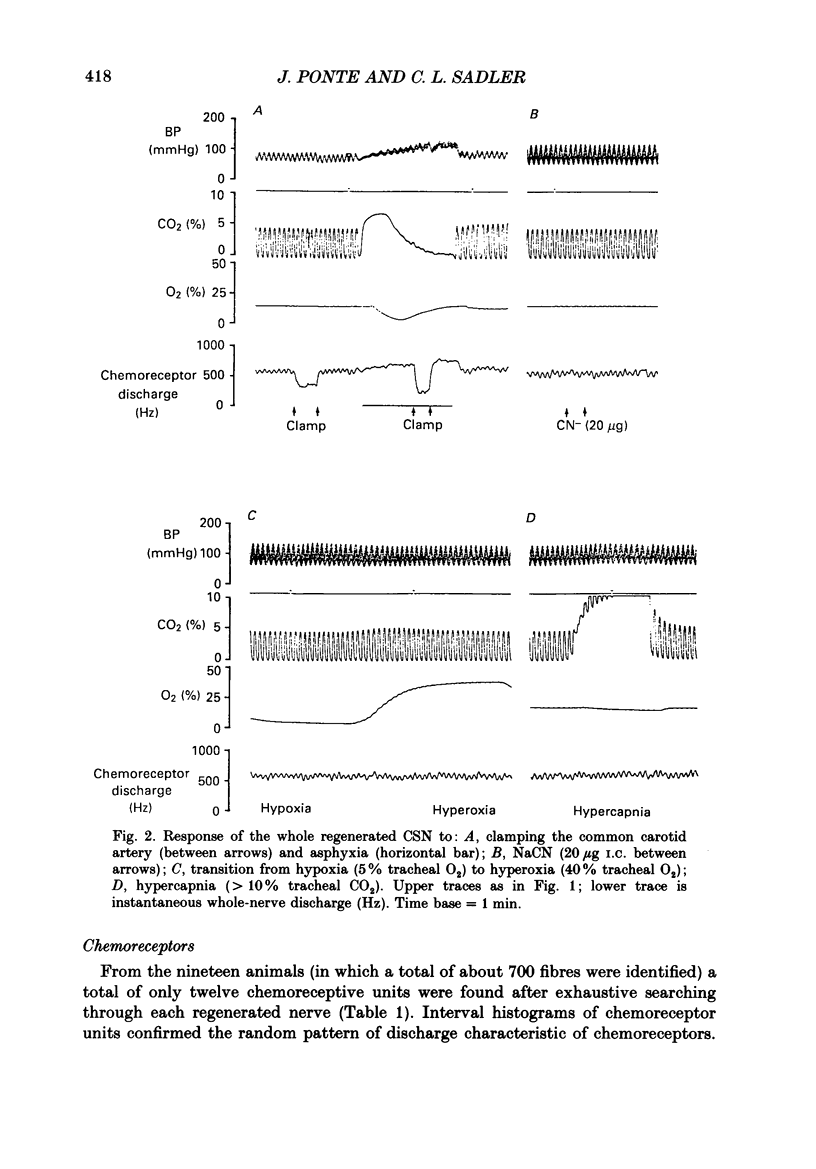Abstract
1. The central end of the distally cut left carotid sinus nerve was sutured to the tunica media of the external carotid artery, 1 cm cranial to the carotid bifurcation, in nineteen rabbits. The carotid body was removed in fourteen of these rabbits but left in situ in the remaining five. After 56-165 days of recovery a neuroma was identified at the site of the suture. Ventilatory reflexes mediated by both sinus nerves were tested and afferent activity recorded from the regenerated nerve. 2. Ventilatory reflex responses to hypoxia and sodium cyanide were abolished on sectioning the right sinus nerve, whilst the hypercapnic response was maintained. 3. Electrical stimulation of the regenerated sinus nerve caused hypotension and hyperventilation. These responses were attenuated compared to stimulation of the right sinus nerve. 4. A level of afferent activity equivalent to that found in non-regeneration experiments was recorded from all regenerated sinus nerves. Whole-nerve afferent activity was modulated by changes in carotid sinus blood pressure but not by changes in Pa,O2, Pa,CO2 (arterial O2 and CO2 pressures) or intracarotid injection of sodium cyanide. 5. A minimum of thirty single afferent fibres was identified in each experiment, the vast majority of which were mechanoreceptors. In only nine experiments were chemoreceptor fibres found and only twelve chemoreceptor fibres (1.7% of total) were identified in these nine experiments. In ten experiments no chemoreceptor fibres could be found. Leaving the carotid body in situ increased the incidence of chemoreceptive preparations. A small number of fibres unresponsive to mechanical stimulation and asphyxia was also identified. 6. The responses of regenerated chemoreceptor fibres to physiological and pharmacological stimuli were generally similar to those found in control carotid body preparations. Fibres unresponsive to mechanical stimulation and asphyxia did not respond to sodium cyanide, dopamine or isoprenaline; some of these fibres were excited by nicotine. 7. The receptive fields of mechanosensitive fibres were localized on or up to 2 cm away from the neuroma. Surface application of 20-40 microliters sodium cyanide (200 micrograms ml-1) was used to localize the receptive fields of seven of the twelve chemoreceptor fibres. All seven were localized to the site of the carotid body. 8. The neuroma and site of the carotid body were examined under light and electron microscopy. Glomus tissue was absent from the neuroma but was found at the site of the carotid body. 9. In conclusion, recovery of chemoreceptor function after carotid sinus nerve section appears to be associated with reinnervation of glomus tissue.
Full text
PDF













Images in this article
Selected References
These references are in PubMed. This may not be the complete list of references from this article.
- Biscoe T. J. Carotid body: structure and function. Physiol Rev. 1971 Jul;51(3):437–495. doi: 10.1152/physrev.1971.51.3.437. [DOI] [PubMed] [Google Scholar]
- Dinger B., Stensaas L. J., Fidone S. J. Cat carotid bodies reinnervated by normal or foreign nerves. Brain Res. 1985 Sep 30;344(1):21–32. doi: 10.1016/0006-8993(85)91185-0. [DOI] [PubMed] [Google Scholar]
- Folgering H., Ponte J., Sadig T. Adrenergic mechanisms and chemoreception in the carotid body of the cat and rabbit. J Physiol. 1982 Apr;325:1–21. doi: 10.1113/jphysiol.1982.sp014131. [DOI] [PMC free article] [PubMed] [Google Scholar]
- Jones S. W. Muscarinic and peptidergic excitation of bull-frog sympathetic neurones. J Physiol. 1985 Sep;366:63–87. doi: 10.1113/jphysiol.1985.sp015785. [DOI] [PMC free article] [PubMed] [Google Scholar]
- Kienecker E. W., Knoche H., Bingmann D. Functional properties of regenerating sinus nerve fibres in the rabbit. Neuroscience. 1978;3(10):977–988. doi: 10.1016/0306-4522(78)90118-5. [DOI] [PubMed] [Google Scholar]
- Matsuura S. Chemoreceptor properties of glomus tissue found in the carotid region of the cat. J Physiol. 1973 Nov;235(1):57–73. doi: 10.1113/jphysiol.1973.sp010378. [DOI] [PMC free article] [PubMed] [Google Scholar]
- Mitchell R. A., Sinha A. K., Mcdonald D. M. Chemoreceptive properties of regenerated endings of the carotid sinus nerve. Brain Res. 1972 Aug 25;43(2):681–685. doi: 10.1016/0006-8993(72)90430-1. [DOI] [PubMed] [Google Scholar]
- Ponte J., Sadler C. L. Interactions between hypoxia, acetylcholine and dopamine in the carotid body of rabbit and cat. J Physiol. 1989 Mar;410:395–410. doi: 10.1113/jphysiol.1989.sp017540. [DOI] [PMC free article] [PubMed] [Google Scholar]
- Verna A., Roumy M., Leitner L. M. Loss of chemoreceptive properties of the rabbit carotid body after destruction of the glomus cells. Brain Res. 1975 Dec 12;100(1):13–23. doi: 10.1016/0006-8993(75)90239-5. [DOI] [PubMed] [Google Scholar]
- Zapata P., Stensaas L. J., Eyzaguirre C. Axon regeneration following a lesion of the carotid nerve: electrophysiological and ultrastructural observations. Brain Res. 1976 Aug 27;113(2):235–253. doi: 10.1016/0006-8993(76)90939-2. [DOI] [PubMed] [Google Scholar]



